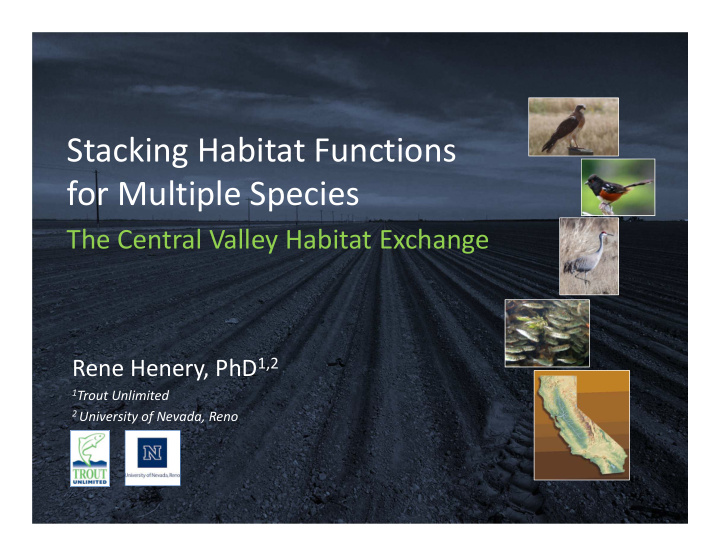



Stacking Habitat Functions for Multiple Species The Central Valley Habitat Exchange Rene Henery, PhD 1,2 1 Trout Unlimited 2 University of Nevada, Reno
The Central Valley Habitat Exchange (CVHE) Partners: American Rivers Environmental Defense Fund Trout Unlimited Point Blue Conservation Science Sacramento ‐ San Joaquin Delta Conservancy Department of Water Resources California Trout Environmental Incentives California Department of Conservation Riparian Habitat Joint Venture (RHJV) Audubon California With support from: Stanford Woods Institute for the Environment Funded By: Natural Resource Conservation Service (NRCS) ‐ CIG
CVHE Stacking • Stacking = Quantifying and crediting species specific ecosystem functions, for multiple species, at a single location
Why Stack? • That’s how natural systems function • Single species mitigation is not working • Saves time and money • Incentivizes functional ecosystems
Stacking Approach • Develop a set of measurable parameters to describe physical and ecological conditions • Define species needs using a subset of those parameters • Look for places where parameters align or can be combined
Stacking Example 6 Water Depth (ft) Chinook Salmon Dabbling Ducks Sandhill Crane 0 J A S O N D J F M A M J Months Chinook Salmon (juveniles) Dabbling Ducks Sandhill Crane
Stacking Example 6 Water Depth (ft) 0 J A S O N D J F M A M J Months Optimal Range Potential Inundation Regime
Challenges and Opportunities • Assumes “restored” landscape provides the greatest benefit (untested) • Requires multiple species to incentivize ecosystem function • Adds a layer of complexity But… • Can also support single species approaches or ecotype ‐ based credits • Flexible and Easily adjusted as new information becomes available • Universally applicable – able to bridge and integrate a wide range of requirements
Recommend
More recommend